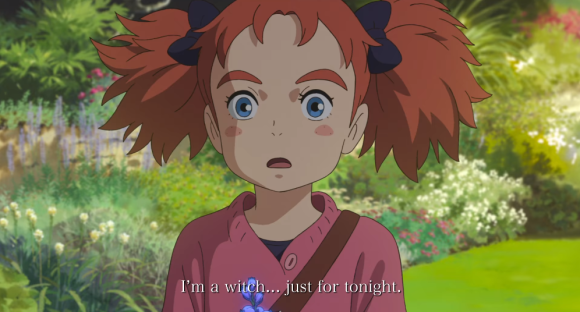
More than a half-dozen key Ghibli creators team up for the first anime film from brand-new Studio Ponoc, but do they do their pedigree proud?
Studio Ghibli is dying.
The last film it released was 2014’s When Marnie Was There, production for which began before veteran director Hayao Miyazaki entered the latest of his many announced retirements. Following the release of Marnie, Ghibli went dormant, a status which lasted until Miyazaki recently decided that he doesn’t want to retire yet after all, and so Ghibli has fired up its engine again for his latest vision.
But eventually Miyazaki will no longer be able to continue being the Lazarus of Japanese animation, and when that time comes it seems pretty clear that Ghibli isn’t going to be interested in having anyone else hold the reins. Hands-on visionary Miyazaki may be, other talented people have also played important roles in the creation of Ghibli’s films, and many of them now find themselves at Studio Ponoc, which has just released its first feature film, Mary and the Witch’s Flower.
Studio Ponoc’s cinematic legacy is born in fire, as the film opens with a young woman escaping from a burning magical laboratory with some sort of stolen item. Pursued by uniformed guards, she hops on a broom and flies away, and almost immediately Ponoc’s lineage is apparent. The guards’ arms stretch, transforming into gelatinous fish-like creatures reminiscent of some of the more surreal sea life from Ghibli’s Ponyo. The girl’s posture as she hunkers down on the broom resembles that of the star of Kiki’s Delivery Service, as does the sequence where she plummets to the earth. When the contents of her bag spill onto the grass and cause vines and trees to begin growing with supernatural speed, it’s hard not to think of the moonlit seed-planting scene from My Neighbor Totoro.
Some of the similarities are striking enough to feel like overt homages, which isn’t all that surprising considering how many Ghibli alumni are involved. Aside from director Hiromasa Yonebayashi (director of Marnie and The Secret World of Arrietty) and producer Yoshiaki Nishimura (producer for Marnie and co-producer for The Tale of the Princess Kaguya), Mary’s scriptwriter, animation director, art director, composer, and sound director all have Ghibli credits on their resumes. Even the Studio Ponoc logo that appears at the beginning of the film, with Mary looking to the left in profile, is reminiscent of the image of Totoro that’s shown before Ghibli movies begin.
The action-packed opening may come as a surprise, given the leisurely pace of Marnie and Arrietty. As a matter of fact, the script (co-written by Yonebayashi and Riko Sakaguchi) in general feels more tightly paced than many recent Ghibli films. Once the escape sequence ends, we’re introduced to Mary, a good-natured and helpful child who’s arrived in at her great aunt’s house a few weeks before starting a new school in the rural community. With time to kill before classes start, she follows a black cat into the forest on a whim, finding a mysteriously beautiful flower that hides a frighteningly powerful strain of magic. From that point, each scene serves to advance the story, with little in the way of the meandering that Ghibli has occasionally indulged in, and Mary’s chance discovery sets off a chain of events that has her traveling to a school for budding witches, where she’s welcomed after showing more spellcraft aptitude than is wise, which ends up having life-threatening implications.
As the story is moving along, the characters themselves are moving with beautifully expressive animation. While the countryside setting of much of the movie doesn’t allow for large crowd shots, in the handful of times when many people are on-screen simultaneously, the animators make sure just about everyone is given something to do. Some of the most impressive sequences showcase a pack of wild animals, with the movements of each alpaca, rhino, and turtle drawn differently from the other species’. Once again, long-time Ghibli fans will notice certain tricks the animators picked up at their former home, such as when Mary’s hair levitates to show agitation, or when she rides a deer bareback like Ashitaka in Princess Mononoke.
In contrast to the misty, subdued hues of Marnie, Yonebayashi’s new film makes use of lush colors, especially when Mary flies through the pink-orange sky at sunset or travels to a school for budding magicians, concealed in the middle of a Laputa-like column of clouds. The design of the school, its headmistress, and cybernetic research scientist all blend intriguingly mysterious and unsettlingly foreboding elements, which to many viewers will feel somewhat akin to Spirited Away.
While the front-and-center characters and their actions are all capable of commanding your attention, you’ll want to let your eyes wander over the amazingly detailed background art as well. It’s so good that at times you might find yourself wishing the characters would step aside for a moment and give you an unobstructed view, and if a Mary and the Witch’s Flower art book is in the works, the backgrounds will be a joy to pore over in printed form.
In what’s become largely the norm for prestige anime films, the voice cast primarily draws from live-action as opposed to dedicated voice actors, although Peter, the first peer Mary meets in her new town, is voiced by Ryunosuke Kamiki, who in addition to live-action roles has a handful of anime credits to his name, including Your Name and Summer Wars leading men Taki and Kenji. The score, from Takatsugu Muramatsu (composer for Marnie) is used sparingly, with the haunting notes heard in the trailer and opening escape sequence the most memorable piece. On the other hand, less music gives sound director Koji Kasamatsu (who previously worked on Marnie and The Wind Rises) more aural space to work with, and he does an excellent job, with each footstep punctuated with the echo of wood flooring, shuffle of gravel, or scraping of stone, which along with the gorgeous background art helps establish a strong sense of place for each location shown.
But while the artistry is consistently impressive, it’s not quite perfect. Characters look great in motion, but they’re sometimes posed awkwardly when standing still. Eyes have a momentary flatness to them on occasion, and some of the characters are given distractingly tall foreheads.
Mary and the Witch’s Flower is also a pretty light meal in terms of thematic statements to chew on. While Mary herself at one point says she’d like to transform into someone else because she feels self-conscious about her red hair, the attempt to tie that into the question of whether or not she should rely on her newfound magical powers doesn’t really work, given that she expresses her wish in only an offhand manner, and before she learns about the existence of magic, no less.
As such, Mary largely has to get by on the appeal of its characters and story. Thankfully, Mary herself remains likeable throughout almost all of the film (compared to Marnie’s Anna, Mary displays less of a tendency to lash out at others in anger, making her an easier protagonist to cheer for), and while she may not have much in terms of a psychological character arc, the trajectory of the story, along with its momentum, are enough to make the film a rewarding watch.
To make one final Ghibli parallel, Mary feels a little like Laputa, in that they’re both self-contained adventure stories that steadily build to a climactic confrontation against clear antagonists. Considering that Laputa was the first film released after the official formation of Studio Ghibli, Mary and the Witch’s Flower seems like a fine starting point for Studio Ponoc.
Images: YouTube/Studio Ponoc /スタジオポノック
Follow Casey on Twitter, where he’d like to thank his dad for taking him to see Silent Mobius on the big screen when he was a kid.

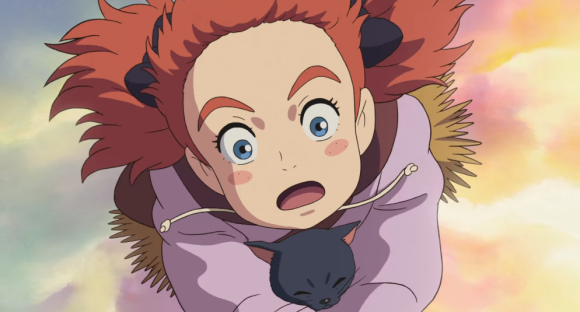
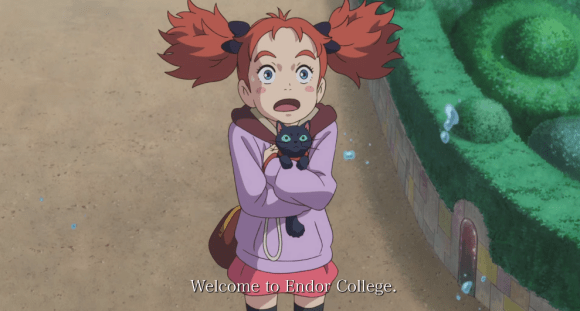
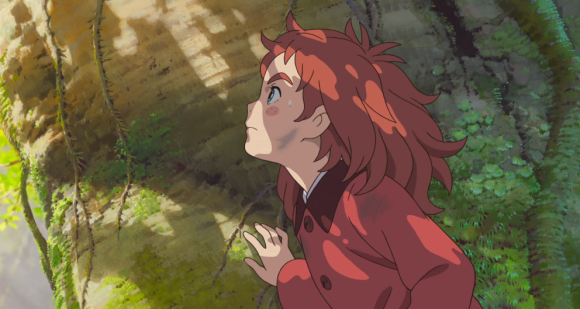
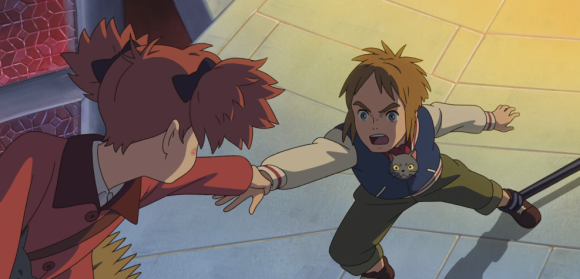
 New anime movie from former Studio Ghibli members is adaptation of British children’s book【Video】
New anime movie from former Studio Ghibli members is adaptation of British children’s book【Video】 Our take on Studio Ghibli’s newest anime, When Marnie Was There【Impressions】
Our take on Studio Ghibli’s newest anime, When Marnie Was There【Impressions】 Hayao Miyazaki spends retirement from anime by…spending every day at his animation studio
Hayao Miyazaki spends retirement from anime by…spending every day at his animation studio Studio Ghibli animator Makiko Futaki passes away at 58
Studio Ghibli animator Makiko Futaki passes away at 58 Ghibli producer provokes backlash for comment regarding abilities of women to direct anime
Ghibli producer provokes backlash for comment regarding abilities of women to direct anime Japan’s new difficult-to-drink-from beer glass protects your liver, but it’s a brutal experience
Japan’s new difficult-to-drink-from beer glass protects your liver, but it’s a brutal experience Demon Slayer: Kimetsu no Yaiba gets new roller coaster attractions and food at Universal Studios Japan
Demon Slayer: Kimetsu no Yaiba gets new roller coaster attractions and food at Universal Studios Japan Come play hide-and-seek on a deserted Japanese island this August and November
Come play hide-and-seek on a deserted Japanese island this August and November New Pokémon ice cream, dessert drinks, and cool merch coming to Baskin-Robbins Japan【Pics】
New Pokémon ice cream, dessert drinks, and cool merch coming to Baskin-Robbins Japan【Pics】 How to order snacks on a Shinkansen bullet train in Japan
How to order snacks on a Shinkansen bullet train in Japan New samurai glasses are Japan’s latest weird must-have souvenir
New samurai glasses are Japan’s latest weird must-have souvenir Burger King Japan suddenly adds Dr. Pepper and Dr. Pepper floats to its menu nationwide
Burger King Japan suddenly adds Dr. Pepper and Dr. Pepper floats to its menu nationwide New Japanese rice cooker cuts carbohydrates at the push of a button
New Japanese rice cooker cuts carbohydrates at the push of a button Turns out you can draw all four original starter Pokémon with just three colored pencils【Video】
Turns out you can draw all four original starter Pokémon with just three colored pencils【Video】 New Nintendo Lego kit is a beautiful piece of moving pixel art of Mario and Yoshi【Photos】
New Nintendo Lego kit is a beautiful piece of moving pixel art of Mario and Yoshi【Photos】 Nintendo history you can feel – Super NES, N64, and GameCube controllers become capsule toys
Nintendo history you can feel – Super NES, N64, and GameCube controllers become capsule toys Hello, cosmetics! Clinique teams up with Hello Kitty this summer for first-time collaboration
Hello, cosmetics! Clinique teams up with Hello Kitty this summer for first-time collaboration “The most Delicious Cup Noodle in history” – Japan’s French Cup Noodle wins our heart【Taste test】
“The most Delicious Cup Noodle in history” – Japan’s French Cup Noodle wins our heart【Taste test】 Starbucks releases a cute Frappuccino and Unicorn Cake…but not in Japan
Starbucks releases a cute Frappuccino and Unicorn Cake…but not in Japan Kyoto Tower mascot termination reveals dark side behind cute Japanese characters
Kyoto Tower mascot termination reveals dark side behind cute Japanese characters McDonald’s Japan’s Soft Twist Tower: A phantom ice cream only sold at select branches
McDonald’s Japan’s Soft Twist Tower: A phantom ice cream only sold at select branches Yabai Ramen: What makes this Japanese ramen so dangerous?
Yabai Ramen: What makes this Japanese ramen so dangerous? Finally! Nintendo Japan expands Switch 8-bit controller sales to everybody, Online member or not
Finally! Nintendo Japan expands Switch 8-bit controller sales to everybody, Online member or not Japanese government wants to build luxury resorts in all national parks for foreign tourists
Japanese government wants to build luxury resorts in all national parks for foreign tourists To combat declining birth rate, Japan to begin offering “Breeding Visas” to foreigners
To combat declining birth rate, Japan to begin offering “Breeding Visas” to foreigners 10 things you should buy at 7-Eleven in Japan
10 things you should buy at 7-Eleven in Japan Studio Ghibli releases anime heroine cosplay dresses that are super comfy to wear
Studio Ghibli releases anime heroine cosplay dresses that are super comfy to wear Woman charged for driving suitcase without a license in Osaka
Woman charged for driving suitcase without a license in Osaka Studio Ghibli unveils My Neighbour Totoro miniature house model
Studio Ghibli unveils My Neighbour Totoro miniature house model Kyoto experiencing problems with foreign tourists not paying for bus fares, but not on purpose
Kyoto experiencing problems with foreign tourists not paying for bus fares, but not on purpose Fighting mild hunger with a Japanese soda that turns into jelly in the stomach【Taste test】
Fighting mild hunger with a Japanese soda that turns into jelly in the stomach【Taste test】 Studio Ghibli’s Howl’s Moving Castle tapestry unveiled in Japan for first time
Studio Ghibli’s Howl’s Moving Castle tapestry unveiled in Japan for first time McDonald’s new Happy Meals offer up cute and practical Sanrio lifestyle goods
McDonald’s new Happy Meals offer up cute and practical Sanrio lifestyle goods Sales of Japan’s most convenient train ticket/shopping payment cards suspended indefinitely
Sales of Japan’s most convenient train ticket/shopping payment cards suspended indefinitely Sold-out Studio Ghibli desktop humidifiers are back so Totoro can help you through the dry season
Sold-out Studio Ghibli desktop humidifiers are back so Totoro can help you through the dry season Japanese government to make first change to romanization spelling rules since the 1950s
Japanese government to make first change to romanization spelling rules since the 1950s Foreigner’s request for help in Tokyo makes us sad for the state of society
Foreigner’s request for help in Tokyo makes us sad for the state of society Ghibli founders Toshio Suzuki and Hayao Miyazaki contribute to Japanese whisky Totoro label design
Ghibli founders Toshio Suzuki and Hayao Miyazaki contribute to Japanese whisky Totoro label design Doraemon found buried at sea as scene from 1993 anime becomes real life【Photos】
Doraemon found buried at sea as scene from 1993 anime becomes real life【Photos】 Tokyo’s most famous Starbucks is closed
Tokyo’s most famous Starbucks is closed Princesses, fruits, and blacksmiths: Study reveals the 30 most unusual family names in Japan
Princesses, fruits, and blacksmiths: Study reveals the 30 most unusual family names in Japan Studio Ghibli retail chain brings out a mystery fukubukuro lucky bag for New Year
Studio Ghibli retail chain brings out a mystery fukubukuro lucky bag for New Year Studio Ghibli finishes free-to-use image release with 250 from Nausicaa, Laputa, and more
Studio Ghibli finishes free-to-use image release with 250 from Nausicaa, Laputa, and more Poster for Ghibli’s new movie under fire … from the big guru himself!
Poster for Ghibli’s new movie under fire … from the big guru himself! Hayao Miyazaki has secret concept for next anime, considers all animators his rivals, son says
Hayao Miyazaki has secret concept for next anime, considers all animators his rivals, son says Toronto Film Festival to host North American premiere of Princess Kaguya, Ghibli documentary
Toronto Film Festival to host North American premiere of Princess Kaguya, Ghibli documentary Hayao Miyazaki’s The Boy and the Heron nominated for Academy Award
Hayao Miyazaki’s The Boy and the Heron nominated for Academy Award Studio Ghibli-licensed store Donguri Kyowakoku brings us the fukubukuro lucky bag of our dreams
Studio Ghibli-licensed store Donguri Kyowakoku brings us the fukubukuro lucky bag of our dreams Studio Ghibli producer dishes the dirt on Hayao Miyazaki, Your Name, and their next big project
Studio Ghibli producer dishes the dirt on Hayao Miyazaki, Your Name, and their next big project British newspaper ranks the best Studio Ghibli films and reader passions flare
British newspaper ranks the best Studio Ghibli films and reader passions flare Have you seen them all? The top 10 Ghibli films Japanese college students haven’t watched
Have you seen them all? The top 10 Ghibli films Japanese college students haven’t watched Ghibli reveals genre of Hayao Miyazaki’s next anime, and that it’s also working on new CG film
Ghibli reveals genre of Hayao Miyazaki’s next anime, and that it’s also working on new CG film An anime film to overtake Your Name? This one might just have what it takes【Video】
An anime film to overtake Your Name? This one might just have what it takes【Video】 Ghibli Park releases new info, preview images for Howl’s Moving Castle, Princess Mononoke areas
Ghibli Park releases new info, preview images for Howl’s Moving Castle, Princess Mononoke areas 10 best Studio Ghibli anime, as picked by Japanese fans– Different ages have different answers
10 best Studio Ghibli anime, as picked by Japanese fans– Different ages have different answers The Place Where Totoro Was Born: New Studio Ghibli book includes art by Hayao Miyazaki’s wife
The Place Where Totoro Was Born: New Studio Ghibli book includes art by Hayao Miyazaki’s wife
Leave a Reply